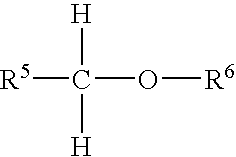Process for preparation of cyanoacrylate compositions
a technology of cyanoacrylate and composition, which is applied in the field of preparation of polymerizable cyanoacrylate composition, can solve the problems of difficult production of even dispersion of particulate silica in the composition, and the maintenance of such dispersion, and achieve the effects of reducing undesired or uncontrolled side reactions, viscosity enhancement, and viscosity enhancemen
- Summary
- Abstract
- Description
- Claims
- Application Information
AI Technical Summary
Benefits of technology
Problems solved by technology
Method used
Image
Examples
example 1
[0054] To the reaction vessel is introduced 50.0 ml butyl cyanoacrylate, rendered substantially free of free-radical stabilizers by passing through a 10″×¾″ column of absorbent (Aldrich Chem Co.). The reaction vessel content is degassed via three freeze-pump-thaw cycles after which the vessel is maintained under an argon atmosphere. The circulating water temperature is set and maintained at 20° C., stirring is commenced and the UV lamp is ignited. After 10.0 min. the UV lamp is extinguished and 100 ppm 4-methoxy phenol, 100 ppm hydroquinone and 25 ppm sulfur dioxide are immediately introduced into the reaction mixture. Viscosities of the initial and final compositions are measured at 20° C. with a Brookfield cone and plate viscometer. Initial viscosity=4.0 cps and final viscosity=35.5 cps
example 2
[0055] To the reaction vessel is introduced 95.0 ml 2-octyl cyanoacrylate and 5.0 ml n-butyl acrylate, rendered substantially free of free-radical stabilizers by passing through a 10″×¾″ column of absorbent (Aldrich Chemical Co.). The reaction vessel content is degassed via three freeze-pump-thaw cycles after which the vessel is maintained under an argon atmosphere. The circulating water temperature is set and maintained at 10° C., stirring is commenced and the UV lamp is ignited. After 10.0 min the UV lamp is extinguished and 100 ppm 4-methoxy phenol, 100 ppm hydroquinone and 25 ppm sulfur dioxide are immedialty introduced into the reaction mixture. Viscosities of the initial and final compositions are measured at 20° C. with a Brookfield cone and plate viscometer. Initial viscosity=4.5 cps and final viscosity=56.0 cps.
example 3
[0056] The data presented in table I demonstrate the shear thinning behavior of compositions comprising 2-hexyl cyanoacrylate prepared by the process of examples 1 and 2 above. In the present example a Brookfield LVCP (cone and plate) viscometer equipped with a No. 40 spindle is used. Since for a given composition, an increase in spindle speed relates to an increase in in shear rate, these data readily demonstrate that for each of the compositions A, B, and C apparent viscosity is reduced as shear rate (spindle speed) is increased.
TABLE ISpindleApparentCompositionSpeed (rpm)Viscosity (25° C.)A1.00417.0039B0.75704.5039C0.301572.00141
PUM
| Property | Measurement | Unit |
|---|---|---|
| Wavelength | aaaaa | aaaaa |
| Wavelength | aaaaa | aaaaa |
| Composition | aaaaa | aaaaa |
Abstract
Description
Claims
Application Information
 Login to View More
Login to View More - R&D
- Intellectual Property
- Life Sciences
- Materials
- Tech Scout
- Unparalleled Data Quality
- Higher Quality Content
- 60% Fewer Hallucinations
Browse by: Latest US Patents, China's latest patents, Technical Efficacy Thesaurus, Application Domain, Technology Topic, Popular Technical Reports.
© 2025 PatSnap. All rights reserved.Legal|Privacy policy|Modern Slavery Act Transparency Statement|Sitemap|About US| Contact US: help@patsnap.com



